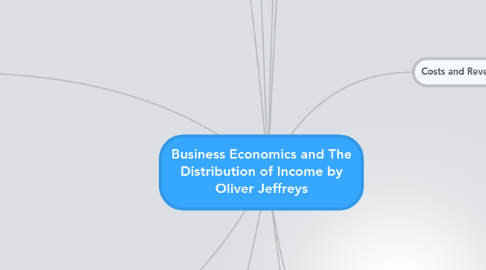
1. Perfect Competition
1.1. Perfect Competition
1.1.1. Sunk Costs
1.1.1.1. Costs that cannot be recovered e.g advertising
1.2. The Short Run
1.2.1. The Shutdown Condition
1.2.1.1. P<AVC
1.3. The Long Run
1.3.1. The Shutdown Condition
1.3.1.1. P<AC
1.4. Theory and Reality
1.4.1. Factors on which firms compete in imperfectly competitive markets
1.4.1.1. Quality, Brand, Choice
1.5. The benefits of competition
1.5.1. Lower prices, low barriers to entry, lower total profits, greater entrepreneurial activity, economic efficiency.
2. Efficiency,Consumer and Producer Surplus
2.1. Consumer Surplus
2.1.1. Difference between the price the consumer is prepared to pay and the price they actually pay.
2.2. Producer Surplus
2.2.1. Difference between price the producer is prepared to supply and the price they actually receive.
2.3. Static vs Dynamic Efficiency
2.3.1. Static = Allocative, Productive, X
2.3.2. Dynamic = Product, Process
2.4. Allocative, Prductive, X Efficiency
2.4.1. Allocative
2.4.1.1. Occurs where goods are produced in line with consumer preferences. P=MC
2.4.2. Productive
2.4.2.1. Occurs at the lowest point on the average cost curve
2.4.3. X
2.4.3.1. Where firms are not on the AC curve owing to organisational slack
2.5. Dynamic Efficiency and Technological Change
2.5.1. Dynamic = over time. Product and process innovation
2.6. Government policy and Dynamic Efficiency
2.7. Is Perfect competition an efficient market structure?
2.7.1. Deadweight Loss
2.7.1.1. The welfare loss associated with monopoly power
3. Price Discrimination
3.1. Occurs when a producer sells an identical product to different buyers at different prices for reasons unrelated to costs.
3.2. Conditions necessary for price discrimination to occur
3.2.1. Differences in PED, Barriers to prevent "market seepage"
3.3. Types of price discrimination
3.3.1. 1st, 2nd, 3rd degree
4. Oligopoly
4.1. Market dominated by a few producers, each of which has a degree of control in the market, so market is likely to have a high level of market concentration.
4.2. The Kinked Demand Curve
4.3. The importance of non-price competition
4.3.1. service quality
4.3.2. Longer opening hours
4.3.3. Discounts on product upgrades
4.3.4. Contractual relationships with suppliers
4.3.5. Increased range of services
4.3.6. Advertising and loyalty cards
4.4. Price leadership, collusion and fixing
4.5. Game theory
5. Market Structures and Technological Change
5.1. The organisational and other characteristics of a market
5.2. Price makers vs. price takers
5.3. The impact of technology on firms and markets
5.3.1. Technology has the capacity to enhance production and consumption possibilities
6. Costs and Revenues
6.1. Fixed and Variable Costs
6.1.1. Fixed Costs
6.1.1.1. One that does not change with output e.g paying for patents
6.1.2. New node
6.1.2.1. Variable Costs
6.1.2.1.1. One which changes with output
6.2. Short Run Average Cost Curve
6.2.1. Average Cost = Total Cost/Quantity
6.2.2. The Short Run
6.2.2.1. Period of time where at least 1 factor of production is fixed
6.2.3. The law of diminishing returns
6.2.3.1. As more of a variable factor is added to a fixed factor, marginal product initially rises but will fall as diminishing returns sets in
6.2.4. Marginal Product
6.2.4.1. The addition to total product from production of 1 extra unit of output
6.2.5. Average Cost Calculations
6.2.5.1. AC = AFC + AVC
6.2.5.1.1. AC = TC/Q
6.3. The Long Run Average Cost Curve
6.3.1. Economies of Scale
6.3.1.1. Falling long run average costs. Where an increase in all factors of production lead to a more than proportional increase in output.
6.4. The Minimum Efficient Scale
6.4.1. The point where the lowest AC is first reached on the LRAC curve. The point where all economies of scale are exhausted.
6.5. External Economies and Diseconomies of Scale
6.6. Total, Average and Marginal Revenue
6.6.1. Total Revenue = Price X Quantity
6.6.2. Average Revenue = TR/Q
6.6.3. Marginal Revenue = addition to total revenue from sale of one extra unit of output
7. Profit Maximisation
7.1. What is Profit?
7.1.1. Normal Profit
7.1.1.1. Where profit is just sufficient to keep all factors of production in their present use. AC = AR
7.1.2. Supernormal Profit
7.1.2.1. Anything in excess of normal profit.
7.2. Maximising Profit
7.3. Theory and Reality
7.4. The Role of Profit in The Economy
7.5. Alternative Goals
8. Concentrated Markets
8.1. Why do firms grow larger?
8.1.1. Market power motive, objectives of managers, profit motive, economies of scale, risk motive.
8.2. How do firms grow larger?
8.2.1. Internal growth, external growth, Outsourcing
9. Monopoly
9.1. Barriers to entry
9.1.1. High fixed costs, Economies of scale, brand loyalty, legal barriers, control over factors of production, control over retail outlets, predatory pricing.
